#stirrups in construction
Explore tagged Tumblr posts
Text
Discover the essential role of stirrups in construction. Learn about their benefits and the different types available, ensuring structural stability in various projects. Dive into this detailed guide by Shree TMT for expert insights.
#Stirrups in construction#types of stirrups#construction stirrups benefits#role of stirrups#stirrup types guide#construction materials#building stability#shreetmt#construction industry#tmt bars#building strength#building foundations#construction#construction safety#building materials
0 notes
Text
Buy Tata Tiscon's Superlink Stirrups Bar Online At Best Price
Buy Tata Tiscon superlink stirrups bars online for superior quality & interlocking technology. It helps to save construction time and space on the sites.
#stirrups#stirrups in column#stirrups in beam#types of stirrups#stirrups in construction#Tata Tiscon superlink stirrups bars#stirrups bars#stirrups bars online
0 notes
Text
Automatic Stirrup Bending Machine price in India: Latest price
Introducing the Automatic Stirrup Bender – a game-changer for construction professionals in India. This innovative machine simplifies rebar stirrup production, offering precision, efficiency, and safety.
https://sonavibrators.com/category-details/53/stirrup-bending-machine

#best quality#construction#machine#prices#Automatic Stirrup Bending Machine#sona automatic rebar stirrup bending machine price#stirrup bender#automatic stirrup making machine#rebar stirrup bending machine
0 notes
Text
So you want to write about horses.
Part 2 now out!
Or you're writing and horses show up. Or its a pre-industrial fantasy and your characters have to get somewhere. Or you have a faint idea of your MC's love interest showing up on a white stallion.
Whatever the cause, you're writing, and a horse appears. But you know nothing about horses. I can help.
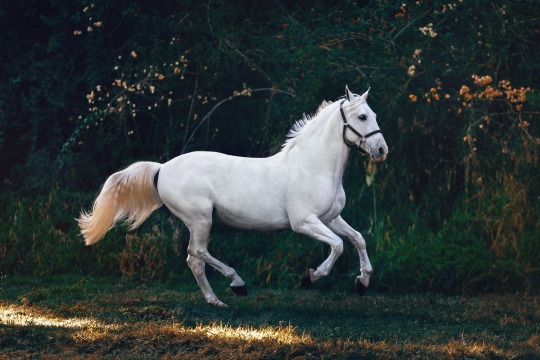
This is a horse. Horses come in many sizes.
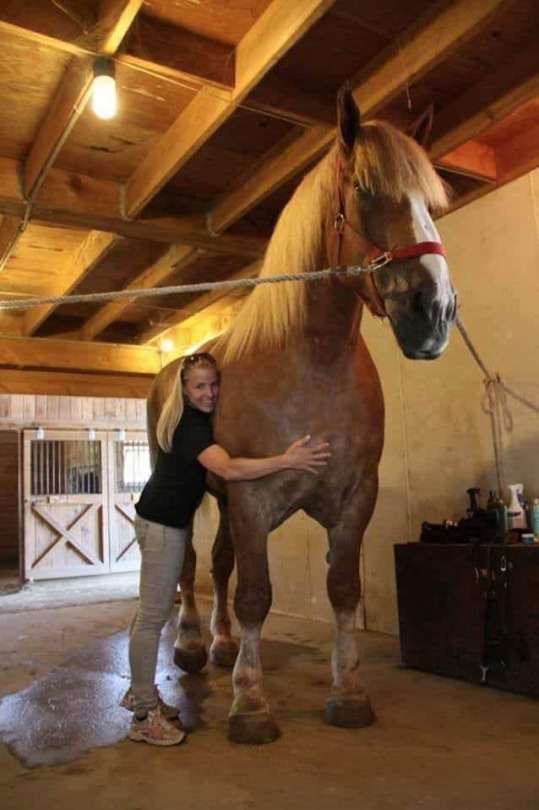
^ Big Jake, a Belgian Draft horse, and a roughly 5 foot woman for scale.
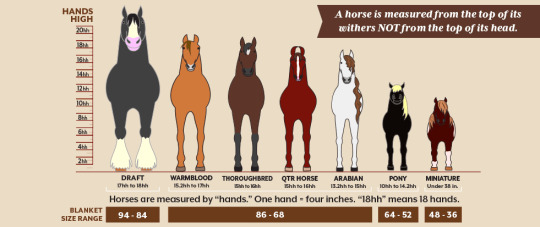
1 hand = 4 inches = 10.16 cm
Once a horse is smaller than about 14.2hh, it is generally considered a pony. In the modern day, ponies are not considered suitable for adult riders due to weight and height issues. Some pony breeds, such as Welsh, Fjords, ect. are known for being sturdy, and can more easily carry adult sized humans. Miniature horses should never be ridden by adults.

^The only suitable 'riding' a miniature horse should do
The above graphic mentions that horses are measured from the top of the withers, not the top of the head. But, what are withers?
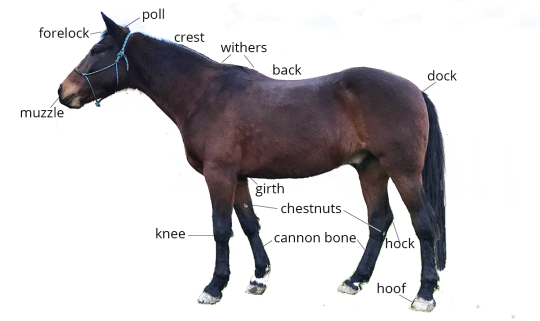
The withers are where the horse's shoulders meet the spine, and the neck becomes the back. Withers are incredibly important for saddle placement, as a badly placed saddle in this area can prevent a horse from moving its legs properly, cause a large amount of pain, and even damage a horse's spine. Speaking of spines, this is a horse skeleton, with the withers pointed out.
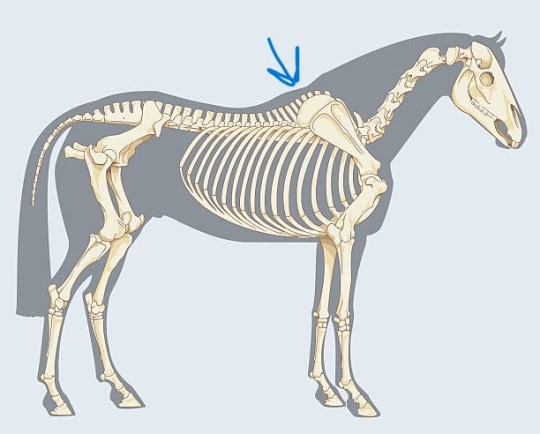
Horses have four legs. Horses cannot have any fewer than four legs. They are obligate quadrupeds. This is, in part, due to their weight, as well as the construction of their legs and hooves. This is to say, that while cats, dogs, and other animals can be amputees, a horse, short of some incredible magic solution, cannot. Even a broken leg bone will cause a huge amount of problems, as all of the weight that leg would usually hold must be shifted to the other feet, and this causes a condition called laminitis, where the tissue that holds together the hoof and the toe bone becomes inflamed, and begins to separate. Once this happens, the hoof tissue dies from lack of blood, and the bone begins to rotate. This is extremely painful for the horse, and so often the best solution for a horse with a broken leg is to be spared that pain. Famous American racehorse Barbaro experienced a complex broken bone, which began to heal fine, but complications from laminitis in two of his other legs caused him to be put down. This is why media will almost always show a horse with a broken or injured leg being 'taken care of'.
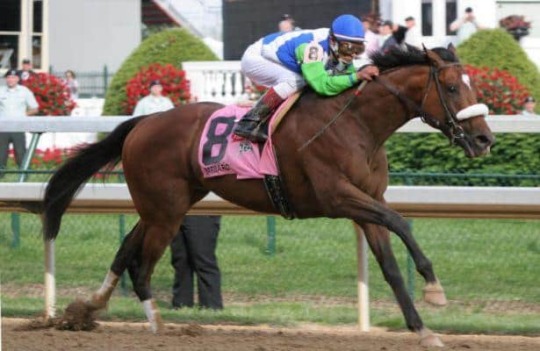
^Barbaro, in his prime. Even the best veterinary medicine couldn't save him.
Now, racehorses like Barbaro are moving at the fastest speed and the fastest gait of the horse, the gallop. The patterns that horses move their feet are referred to as gaits, with most horses having four, with some breeds having five or more.
The first gait and the slowest is the walk. In the walk, all four feet move independently, which leads it to be called a four-beat gait, as the footfalls make a sort of drumbeat on the ground.

The next gait is the trot, a two beat gait with diagonal pairs of legs moving together.
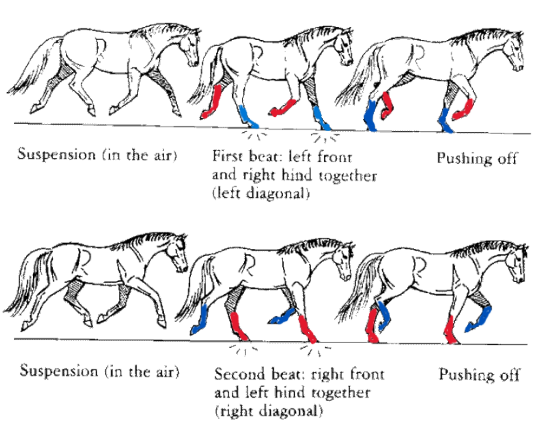
^Diagonal pairs marked in red and blue
The trot is a very bouncy experience for the rider, and can be uncomfortable. Some riders will rise and fall with a pair of diagonal legs, called a posting trot, some will stand in their stirrups, called a two-point or jump position, and some will sit the trot, which requires a lot of core strength (seriously, if you want a strong core, screw the gym)
The third gait is the canter, a three-beat gait with a single diagonal pair. This gait is ridden sitting, and feels a lot like going over waves on a jetski. There is a rise, a scoop, and a fall feeling. The canter is also called a lope in Western riding, they are the same gait.

^diagonal pair marked in red
A gallop is sometimes considered a variation on canter, as it is similar save for the legs actually moving in a four-beat pattern. As you can see with the image of Barbaro, all four of his feet are moving in different patterns, at different times, even though the gallop is really a four beat version of the canter. Riders in the gallop rise off the horse's back into a raised position, which allows the horse to use the full length of its spine and musculature to get as much reach and speed as possible. It feels like riding on top of a train barreling down the tracks, at least until your horse takes an unexpected turn and the ground is suddenly the only thing you're riding.
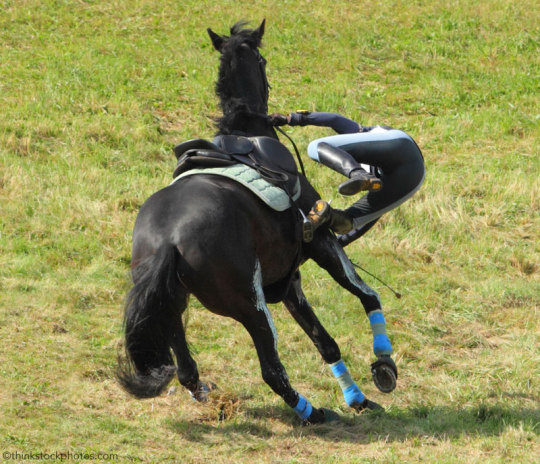
^ I've been there. The trick is to push away and hit the ground rolling, it hurts less that way. And don't land on your head.
That's all for this post. I'll have more when I feel like it, and send me questions if you want to know more about specific things or need a writing question answered
Reblogs welcome and encouraged
@jacqueswriteblrlibrary for wider reach
#writing#writing horses#writer advice#how to write#writing advice#writing help#writeblr#creative writing#writers on tumblr#writeblr community#writers#writerscommunity#horses#basic horse things
1K notes
·
View notes
Text
sapkowski asserting that a definitive feature of the fantasy genre, rooted in arthurian legend, is when the characters go on a quest.

geralt's company makes him a fantasy hero—not just within the internal context of the story (their shared loyalty drives him to the leadership he once shunned, he must grow as a character to embrace it)—but also within the external context of his construction as a character.
could he even be a hero of the genre, without his company? they are just as much of a convention of it as he is.
by the genre convention, they are as critical to geralt's character as his love interest and maiden-to-rescue (in geralt's case, his daughter). what is king arthur, after all, without his knights of the round table!
furthermore... the member's of geralt's company are often regarded separately, as individuals, for their unique stories and characters, but it should be more acknowledged that in their friendship, in their fellowship, they also come to exist as a kind of singular entity.
and to me, this is also why they die together, all sacrificed at the same time.
they became inseparable, because it was their fate. not only in-universe, but how they must be, as characters, as a united company. it was only their destiny, as they are defined by the journey they go on. as would make them:
... companion[s] with whom one travels stirrup by stirrup, day in day out, and who [sleep] under the same blanket at night.
#the witcher books#f: a hansa's a hansa#sincerely what is better than a group of friends going on a quest#when they left beauclair knowing they were going to die but were still hyped as fuck for it because QUEST QUEST QUEST#analysis#the elbow-high diaries
19 notes
·
View notes
Text
I went to a summer camp that was focused on horseback riding through the mountains of kananaskis when I was younger.
And what a beautiful experience that was. Gorgeous mountains and calming lakes, splashing around the base of a small waterfall with new friends. Sitting by that lake and having my mind go quiet all on it’s own for the first time in my life as I focus on the sound of the birds around me.
Clear skies and trail songs and simple but satisfying meals after long days in the sun. Even in the cold rain it’s incredible.
And the horses, incredible animals. So full of personality, and many of them so sweetly patient with us kids. Patient as we learned to get them to lift their hooves for picking, as we struggled to get their buckets of grain feed hooked up for them to eat before a ride. Patient as we learned how to hoist their big heavy saddles onto their backs, blankets and pads and all, when their shoulders lied above our own. I always revelled in that feeling of sheer strength and competence, to get that big construction of leather and metal all the way up there.
And I loved the smell of the barn, with all the saddles on their posts, the blankets placed on top to air out between rides. It smelled like effort and wood and leather and I loved it. When I couldn’t go take out the hay to the feeders with the others because I started to get hives from it, I volunteered to sweep the barn. I was in there for what felt like eternity, practically meditating. Quietly getting to know every odd nook and crevice of this rugged place, surrounded by that handsome air.
And the next day I went back into that barn with satisfaction, proudly hoisted up my horse’s saddle and marched over to his post, ready for another day on trail. But instead we did some movement exercises before we left, to work on control and critique the way we hold our reins.
They had us walk our horse forward into a small circle of pylons, turn them around in a tight circle and then walk back out and stop. This was harder than it sounds based on the other campers’ attempts, though all of them did really well on their second go around. But I calmly got up in the saddle, took the reins, and guided my horse in a tight circle without bumping a single pylon or having him step outside them. We nailed it. I kept it cool, but I was soooo… I was so proud of myself and my horse. I felt so skilled and confident in a way I never had before.
And the rugged jeans I wore and all the plaid I brought along. I was not the only one in plaid by far, but I did not wear as many tights as everyone else. And I loved to put on my boots, the ones with just enough heel for the stirrups. And I loved doing up the straps of the saddle as carefully but efficiently as I could.
I loved the mountain views and the beauty and joy of the freshwater, I loved feeling rugged, I loved feeling competent and worked, I loved the smell of the summer air and the sweat and leather and wood of the barn. I loved to get the dust out of my horse’s coat in the morning with that big thick brush with hard smooth strokes and a flick.
That camp made me feel more like a man than I knew. I wish I could’ve revelled in it the way I would now. I wish I had volunteered to chop the wood like I had wanted. But I did always carry the most logs back to our campfire, and filled with pride when I looked at the light red marks on my forearms from the scraping bark.
Now, if only I liked hats.
#trans guy#trans dude#trans man#transman#transmasc#trans masc#transmasculine#trans thoughts#transgender#jo-dracona gender#jo dracona gender
33 notes
·
View notes
Text
“Keep the turns gentle, and no aerial maneuvers,” Ariquar says for what feels like the seventeenth time since he's called the dragon before him into the temple gardens. Belqoriik’s white wings shuffle as he keeps his neck low to the ground so Ariquar can reach around him. He turns one large, sky-blue eye to Ariquar and the human apprentice beside him. He's young, red-haired and freckled, hair pulled back with a strap of cloth around his forehead. He's obviously nervous, but hiding it with the way he's clenching his fists at his sides.
“I will not drop the hatchling, Dovahkiin. I have not dropped you, geh?” The dragon’s lips curl upward, almost as though he's smiling.
“You have not,” Ariquar agrees, pulling one of the saddle straps tighter. Belqoriik only shifts to aid in the adjustment, pulling his neck slightly away. Once the strap is tightened, Ariquar shows the human man to the stirrup, continuing his conversation from before. “But I have more experience riding on your kind, saddled and unsaddled.”
“Hm.” Belqoriik turns now, making sure his neck is straight and even so the human can find his place. Ariquar helps in that, showing him where to latch himself in.
“Think you're ready, Orrin?” Ariquar asks. Orrin — that's the human’s name, Belqoriik remembers — nods once, his hands gripping the handle of the saddle.
The design was the result of Ariquar and the dragons working together to find something comfortable for both the rider and the dragon — long leather straps wrap around the neck and chest, secured over the shoulder of the wings. The seat rests at the base of the neck, rather than near the head, and only the dragons who either bear short spines or were willing to have them modified have been fitted for saddles.
Orrin settles in lower. Belqoriik thinks about jokingly shaking him just to see his reaction, but decides not to once he feels just how nervous the poor boy is. His legs are anxiously tapping his sides, and Belqoriik hums low in his chest to calm him.
“Drem, youngling. I will not drop you. Your kinbok would have my head if I did.”
“It is something truly unprecedented, to fly. For humans.” Orrin says. His voice is low, and Belqoriik thinks that he may be controlling his volume so Ariquar doesn't hear.
“Humans are not built for flight. But neither are elves, and your kinbok handles it quite well.” Belqoriik says. He takes a step forward. Orrin grips the saddle tighter.
“He's got the soul of one of you, though.” Orrin says. Belqoriik laughs, a rumbling, crackling noise like ice breaking near the Windhelm docks.
“That does nothing for his body. He is as fragile as you, when it comes to this.”
Orrin seems to relax at that. But still his grip is strong, holding on while Belqoriik begins to move forward in earnest toward the newly-constructed flight platform of the temple gardens. It juts out to serve as a place for dragons to pick up speed before taking off — nearby there are also newly built perches of sorts, hewn from metal and stone. Orrin gets one good look at one of the dragons perched, watching — and then he's shaken from the view as Belqoriik jumps, wings spread to glide downward. The dive is faster than Orrin expected, whipping his hair back and pressing his heavy coat to his body, and then —
Belqoriik flaps his wings, and it feels as though Orrin is being tossed for a moment before he gets his bearings. After several more flaps of his wings, Orrin seems to catch the rhythm of it and braces for each movement. Belqoriik arcs his neck just so to get a glance in Orrin’s direction, then he tilts his wings to turn in the air.
Down below, the sprawling camp of the reachfolk looks miniscule. Orrin looks over the other side of Belqoriik’s body, taking in the long, winding rivers and open wildlands.
He's seen so much of Skyrim, but it’s never been put in this sort of perspective. It looks small in a strange way, yet vast in another that he can't quite comprehend.
“Settled?” Belqoriik asks. The wind is loud enough that Orrin isn't sure his voice will be heard over it, but he tries to reply, shouting in the affirmative.
Belqoriik tilts a wing again, turning into a slow descending circle. A slow and easy way to get the human on his back more accustomed to flight, rather than taking him up into the clouds and the chilling, biting air there. Perhaps he will convince Ariquar to allow him to fly this human further out, into the hills and valleys across Skyrim.
(It is a strange thing to want company. Even stranger to want it in the form of mortals — though, Belqoriik, like all of the dragons staying under Ariquar’s banner, have found that mortals make such interesting conversation despite their short lives. Or, perhaps, because of that very reason.)
Their flight lasts only as long as it takes for the sky to become clouded. Before the weather can turn wet and cold, Belqoriik flies them back to the temple, where he lands in the gentlest way he can muster. Humans and mortals are all so fragile.
Orrin undoes the saddle straps, climbing down onto the solid ground once more. Ariquar is there to greet him, steadying him with both hands.
“How did it go?” Ariquar asks.
Orrin runs his fingers through his own hair. It's gotten tangled from the wind — he'll braid it before the next time.
Next time?
“It went well.” Belqoriik says. “Your youngling-apprentice settled into flight quite easily.”
“Is that so,” Ariquar says, rubbing his bearded chin with one hand. Something in his eyes tells Orrin that he's planning something. Orrin says nothing in response, only holding onto the hope that he'll be chosen for the next flight.
Belqoriik reaches out with his long snout — white-scaled, nearly pearlescent on sunny days — and taps Orrin in the back just as he and Ariquar turn to head back into the temple walls.
“You have bravery, to fly such heights.” He says, and Orrin seems taken aback.
“Thank you?” He says sheepishly, and Belqoriik grins at him, all of his dagger-sized teeth on full display.
“When the weather is warmer and you will not freeze to death, I will take you into the skies once more. Higher, then, so you can truly see what you mortals have never been able to.” He nudges Orrin again, who now reaches out and puts a hand on the end of his snout.
“I will look forward to it. And I will be less terrified.”
#orrin#ariquar#belqoriik was a spur of the moment idea#i knew i wanted a specific Feel for some of the dragons Ari recruits into the blades but i never really settled on any Characters#so maybe.... look forward to me designing dragons now?#anyway. this was written instead of me sleeping. i need to sleep. real badly.#if this feels weird blame that. i just needed something to put my brain at ease before sleep
8 notes
·
View notes
Text
Another difference in Hebitian vs Cardassian clothes that I didn't mention while answering the ask @nebulouscoffee sent me is their shoes!
We don't see much of the shoes on Trek characters really, but we do see Dukat and Garak’s a few times. Dukat infamously has "Polly Pocket boots", and Garak's are more shapely, but still look to be simple boots (for detail shots, look at the final scene in Improbable Cause and one of Garak’s infirmary scenes with the gold suit- I don't remember which but you see his shoes and the stirrups on the ends of his pants). In all three cases, their shoes color coordinate to their pants- if you think Cardassians like height in men, this makes sense, color matching your shoes and pants is a visual illusion that lengthens the leg and makes you look taller.
Overall canonically, Cardassian shoes seem to be very practical. An arguable exception would be the shoes I recall Garak making for Kira while she was pregnant, which are ankle boots but had a big block heel (which, forgive me if I'm wrong, sounds terrible), but those are based on her normal uniform shoes, which are a Bajoran design, so how much Cardassian influence in those depends on how much you think Cardassian aesthetics have influenced Bajoran uniforms.
(The Doylist explanation of course, is that the costume budget is limited and they just picked simple shoes for the most part)
For my world building, which is based in nothing but my thoughts (we know Hebitians have distinctive clothing because it's mentioned once, but it's never described), I think Hebitians actually favored fairly elaborate shoe designs. Leather or straw slippers (often covered in cloth), painted, gilded, beaded, with cutwork, dye, embroidery, etc. I also think there are a lot more Pre-Union Hebitian shoes floating around in museums and private collections than clothes, as the way a lot of clothes were constructed especially lent itself to being cut and remade or used again in quilts or rags.
#cipher talk#ds9#Hebitians#ASIT#Cardassians#The elaborate shoes are largely based on how elaborate pre-Conquest Coptic slippers are#There's other things too obvs- I think Hebitians often wore large belts which is based on the fact that Garak does but no other Cardassians#Do so. It might not even be a conscious fashion choice- it could be its still retained in the service class
19 notes
·
View notes
Note
ineffables + jousting?
A/N- ooh medieval?! nice . Although I have to say this is more fuelled by BBC Merlin and a horsegirl childhood than like . actual jousting probably
a little bit angstier than I usually go with these ficlets , but in a precursor-to-1941 way
prompt me: ineffables + historical settings . (I’m also taking gentlebeard / ed x stede prompts bc the ofmd obsession is Setting In)
Read on AO3
A grandstand has been constructed on the large green. Noble spectators watch as their champions mounted on the fiercest, showiest mounts charge each other and do their darndest to render their opponents helpless in the dust.
It’s not Aziraphale’s preferred method of entertainment, but he’s gone and got himself wrapped up with the knights’ order and so here he is. Better than actual war, he supposes. It’s just a spot of show, and afterward the meat and mead will flow aplenty. Jolly good then. So he straps up his armour plating to his waist and his arms and his legs and gosh there is a lot of this isn’t there? He can see why so many of them have -
“Aziraphale.”
The strapping of his pauldron is suddenly no longer a priority. He hasn’t heard that name in quite some time. He spins toward the entrance of the tent to see a young angel he doesn’t recognise- except of course as an angel, who is extremely conspicuous in garb whiter than snow even though they are clearly attempting to dress as some level of servant.
“Uh, I mean, Lord Fell. Sir,” they hurriedly correct themselves as they enter the tent and attempt to busy themselves with the armour. Aziraphale provides heavy hinting as to what needs to go where and they continue -
“Heaven sends word that the demon Crowley is close. We believe he is at this very gathering.”
Aziraphale does his level best not to smile. It’s been so long!
“That makes sense,” he says instead. “By their rankings there are several powerful humans in attendance. No doubt Hell is going to attempt to make their mark among them. Have no fear ah-“
“Simiel, sir.”
“Have no fear, Simiel. I shall be sure to thwart any such wiles. The demon Crowley has not bested me yet.”
“That’s why I’m here, sir. You see, Heaven feels this will be a fine opportunity for you to best the demon. Once and for all.”
Oh.
Aziraphale’s heart seizes.
Simiel holds out their hands and there appears in them a long, sharp lance. The head of it gleams with metal coating and miracle and Aziraphale winces.
“Blessed silver? Isn’t that a little… drastic?” He swallows down his worry and patches it up as best he can - “I mean what if a human is out there? It would hardly be fair.”
Simiel’s face is unmoved. “Have no fear,” they assure Aziraphale. “It has been arranged.”
The trumpet sounds beckoning Aziraphale to the ring. He marches out and mounts, distinctly unassured. Simiel hands him his lance. A lance designed for the endcap to crack, and for the blade inside to pierce and discorporate and burn and kill.
As promised, a Black Knight with a serpent for a crest rides opposite him. The horse is a massive hulking creature that seems itself to be out for blood. Aziraphale’s mount itches for the challenge. They have precious few seconds. What to do what to do what to do -
A flag waves.
The horses charge.
He has only a few thundering hoofbeats to decide. With Heaven’s eyes on him the only things to do are to stab Crowley, stab that thundering hellbeast - or possibly perfectly innocent mortal horse - he’s mounted on - , or- or-
He lets his feet slip to the very edge of the stirrups, and prays.
His body crunches into the dirt, his head slamming back as his helmet spins away. The hoofbeats come to a halt and with a jingle, his nemesis dismounts.
A hand clasps his and helps him to his feet. He’s dizzy, but uninjured, and Crowley has raised his visor. If Aziraphale is reading him right he might even be smiling.
“A good day for it, Angel,” he says, sportsmanlike.
Aziraphale glances to the side, where the lance lies uselessly in the dirt. By some miracle the cap remains unpunctured, blessed silver hidden safely below. In the distance, Simiel scowls behind their polite applause, and disappears.
Only then does Aziraphale take Crowley’s hand, and allow himself to be lifted to his feet.
#aziracrow#ineffable spouses#ineffable husbands#good omens#gomens fic#Clara’s fic tag#prompt me stuff
2 notes
·
View notes
Text
pollination
it enters me my thoughts come one word at a time being blessed with the paint of love god's divine calling my purpose aphrodite would be envious of me i lie as if my legs draped on stirrups your words never had this potency never this loving like bells echoing in the cathedral we become an impossible construction i am held hostage by germination it all comes to an end soon your weight slumps on me you turn away and i am alone again
2 notes
·
View notes
Text

I actually can point out a fun detail to disprove that! See, a crossbow allows you to 'stockpile' the power of drawn string, and that allows you to draw in advance and aim later.
Why does that matter? Well, you might've seen a little metallic construction at the front of some crossbows.

This, right here, is a stirrup. And like with those you use on horseback, this stirrup allows you to hook your foot inside - except this time, instead of holding you steady, it allows you to hold down the crossbow with your own weight and draw its string not just with your arms, but also with your legs (and your back, I guess) - meanwhile, with a bow, your draw is only as strong as your upper body. Thus, you can put more strength into a crossbow draw, which will be 'stockpiled' until you aim and fire the crossbow.
*repeating crossbows not included in crossbows
10K notes
·
View notes
Text

About the Clear Cover: It is required for protecting the rebar against erosion and providing protection against fire.
? Clear cover is mainly the actual distance from the bottom of fibre to the bottom level of the reinforcement. ? It is also can be said that it is the distance between the concrete extreme fibre and bottom edge of a stirrup.
The thickness of the concrete cover is depended upon the environmental conditions and type of structural member. The minimum thickness of reinforcement cover shall be obtained from the relevant cod of practice. The clear cover should be gaped in 40mm.
About Nominal Cover: It is defined as the concrete cover for its endurance which is maximum 50mm and defined in BS 8110 and AASHTO coarse of the construction cover in the case of over 50mm.
? It is like clear cover but with a different term and introduced in IS Code 456:2000 ? According to this IS Code 456:2000 and section 26.4.1, Nominal cover is mainly the depth design of concrete cover for all the steel reinforcements included links or stirrups. This dimension is used in the design and indicated in the drawings.
Read more
0 notes
Link
Buy Tata Tiscon's super link stirrups bar online with unrivalled quality and interlocking technology. Tata Tiscon supplies customised stirrups for your dream home.
#tata tiscon superlink stirrups with superior durability#tmt bars#stirrups rebar#stirrups#tata tiscon buy online#stirrups in construction#stirrups in beam#tata tiscon distributor#stirrup reinforcement
0 notes
Text
How Stirrups Enhance Structural Stability in Construction
1 note
·
View note
Text
Tack and Gear Essentials: What You Need for Reined Cow Horse Training Success
Reined cow horse competitions demand precision, skill, and the right equipment. Having the right tack and gear is essential for both the horse's performance and the rider's effectiveness. In this article, we’ll explore the essential items you need for successful reined cow horse training.
1. Quality Saddle
A quality saddle is the cornerstone of your tack. It provides comfort for both you and your horse, enhancing performance during training and competition.
Key Features to Look For:
- Correct Fit: Ensure the saddle fits your horse properly. An ill-fitting saddle can cause discomfort and hinder performance. Consult a saddle fitter to find the best option.
- Roping or Reining Design: Choose a saddle designed specifically for reining or cow work. These saddles usually feature a deep seat for better balance and security.
- Sturdy Construction: Opt for a well-constructed saddle made from high-quality leather or synthetic materials to withstand the rigors of training.
2. Headstall and Bit
The headstall and bit play a crucial role in communication between you and your horse. Selecting the right combination can enhance your horse's responsiveness.
Headstall Options:
- Leather vs. Synthetic: Leather headstalls are durable and traditional, while synthetic options are often lighter and easier to clean. Choose based on personal preference and maintenance requirements.
- Adjustability: Look for adjustable headstalls that allow for a customized fit, ensuring comfort for your horse.
Bit Considerations:
- Type of Bit: Consider using a bit designed for reined cow horse events, such as a snaffle or curb bit, depending on your horse’s level of training and responsiveness.
- Comfort: Ensure the bit is comfortable for your horse’s mouth. It should allow for clear communication without causing discomfort.
3. Saddle Pad
A good saddle pad is essential for providing cushioning and protection for your horse's back. It helps absorb impact and prevents saddle slippage.
Features to Consider:
- Material: Choose a saddle pad made from breathable materials that wick moisture away from your horse’s back. Wool and felt pads are popular choices.
- Thickness: Opt for a pad that offers adequate cushioning without being too thick, which can alter saddle fit.
4. Reins
Reins are a vital connection between you and your horse, allowing for precise communication. Choosing the right reins can enhance your control and effectiveness during training.
Types of Reins:
- Split Reins: These reins allow for more versatility in handling and are popular among cow horse riders. They can be adjusted easily for various techniques.
- Roached or Closed Reins: These reins provide a more secure grip and are ideal for riders who prefer a fixed length.
Material Considerations:
- Leather vs. Synthetic: Leather reins are traditional and offer a classic feel, while synthetic options are lightweight and easier to maintain. Choose based on personal preference and usage.
5. Spurs
Spurs can be useful tools for providing additional cues to your horse during training. However, it’s essential to use them correctly and humanely.
Choosing the Right Spurs:
- Types of Spurs: Select spurs with a gentle rowel or a blunt end to minimize discomfort while still providing clear cues.
- Fit and Comfort: Ensure the spurs fit comfortably on your boots and do not rub or irritate your horse's sides.
6. Safety Gear
Safety should always be a top priority in any equestrian discipline. Proper safety gear protects both you and your horse during training and competitions.
Essential Safety Equipment:
- Helmet: Always wear a properly fitted riding helmet to protect your head in case of falls or accidents.
- Boots: Choose riding boots with a heel to prevent your foot from slipping through the stirrup. Ensure they are comfortable and provide adequate support.
7. Grooming Supplies
Keeping your horse clean and well-groomed is essential for health and performance. A good grooming routine can help you bond with your horse and identify any potential health issues.
Grooming Essentials:
- Brushes: Invest in a variety of brushes, including curry combs, body brushes, and hoof picks, to maintain your horse’s coat and hooves.
- Hoof Care: Regular hoof care is crucial for your horse’s overall health. Have a reliable farrier on hand to trim and maintain your horse’s hooves.
8. Training Aids
Training aids can help improve your horse's performance and skills. They provide structure to your training sessions and assist in achieving specific goals.
Recommended Training Aids:
- Ground Poles: Use ground poles to improve your horse's footwork and agility. They can help with balance and rhythm during training.
- Cones and Markers: Set up cones or markers to create patterns for your horse to navigate, enhancing precision and responsiveness.
9. Conditioning Equipment
Conditioning is crucial for your horse’s performance in reined cow horse competitions. Proper conditioning equipment can help enhance your training program.
Essential Conditioning Gear:
- Lunge Line: A lunge line is useful for ground work and conditioning. It allows you to work your horse without riding, promoting fitness and responsiveness.
- Arena Accessories: Utilize barrels, gates, or flags in your training arena to simulate competition conditions and improve your horse’s skills.
10. Trailer and Transport Gear
When preparing for competitions, having the right trailer and transport gear is essential for safely transporting your horse to events.
Trailer Considerations:
- Size and Comfort: Ensure your horse trailer is spacious enough for your horse to stand comfortably during transport.
- Safety Features: Look for trailers with secure tie rings and non-slip floors to ensure your horse's safety while traveling.
Additional Transport Gear:
- Shipping Boots or Wraps: Use shipping boots or wraps to protect your horse's legs during transport, minimizing the risk of injury.
- Hay Net: Bring along a hay net to keep your horse occupied and calm during the journey.
Conclusion
Having the right tack and gear is vital for success in reined cow horse training and competitions. By investing in quality equipment, you can enhance your horse’s performance, improve communication, and ensure safety during training sessions and events. Whether you’re a seasoned competitor or just starting, these essentials will help set you up for success as you embark on your reined cow horse journey. Happy training!
Visit our website at https://rchtolive.com/
0 notes
Photo

Did the title of this Talk slightly make you wince? Yes, the word “crotch” tends to do that. Its etymology branches from the word “crutch” originating back in 1539. No, not the under-our-armpit crutch. Back then, a crutch was the name given to a forked stick farming tool.Today, the word crotch is mostly used to define that part of our body where our torso ends, and our two legs join together. And in clothing, the part of any garment that covers this area of our body is also referred to as its crotch. But in panties, that panel that resides between our legs is factually called a gusset. So, here’s what I know about panty gussets and how they impact fit.What’s Your Pelvis Type?Each of us has our own uniquely shaped pelvis. Think snowflakes. But there are 4 very loosely defined types. And there is no test you can take to learn your type. However, the next time you find yourself staring at the ceiling with your feet in a pair of stirrups, that person between your legs can probably tell you.• Gynecoid pelvis – Most common, round in shape • Anthropoid pelvis – 20-30% of women, oval-shaped from front to back • Android pelvis – Around 20% of women, funnel or heart-shaped with the point aiming forward • Platypelloid pelvis – About 5% of women, oval-shaped from side to sideFor many years now, the lingerie industry has used a standardized width for panty gussets for all panty sizes and styles (but not thongs). Yes, that’s right. Whether you’re an XS or a 5X, the width of your panty gusset is around 8 cm or 3 inches wide. It’s because this width truly does comfortably fit most women. But let me stick a caveat here. Manufacturers who are not versed in making panties, many times don’t know this. This is my pitch to you for why you should at least buy panties from a known lingerie manufacturer.For the narrower Anthropoid pelvis, this standard gusset width could cause a few small vertical ripples in the front and back, but the panty will fit comfortably. For a Platypelloid pelvis, this standardized width may not be enough. If you have the recurring problem with panties riding up in back and/or find that the leg elastic is not resting in your leg creases, you probably have a wide pelvis.There are panty styles available with a wider gusset. You just need to know what to look for. HerRoom always provides a straight-on “front” image for all our panties. Keeping in mind that we are also required to edit all our images in such a way as to not be pornographic or offensive, here is a comparison of a standard width gusset vs. wider gusset options:A panty that makes use of a lace trim around the leg opening will also create a wider gusset. And the boyshort style, due to its added leg length, too, can be a great fit for someone looking for a wider gusset.FYI, the length of a gusset increases about ¾ cm with each panty size increase. A size small/5 panty has around an 11.5 cm or 4.5-inch long gusset. A large/7 panty size will have a 13 cm or about a 5-inch long gusset. Though this is the industry pattern grading recommendation, there are panties out there with longer gussets – mostly the styles without a gathered elastic leg edge.4 Panty Gusset Lining DesignsIt is extremely rare that a gusset in a panty will not have a lining. And a very high percentage have a cotton lining of some type. Our Fitter’s Comments always provide fabric content and lining construction for all the panties we offer for sale. There are 4 primary styles of gusset linings in panties.• Fully enclosed gusset lining – This is the original method for adding a gusset lining. Two gusset seams – one in front and one in back – and sides enclosed within the leg edges. This is how we describe this lining design in our Fitter’s Comments: “Sewn-in cotton crotch. Seamed at front rise and rear.” The position of the front seam is intended to be right at the base of a crotch’s rise. In fact, all rise measurements are measured starting at this line. The only small negative to this lining design is for those few women who find the bulk caused by the front gusset seam irritating.• The “pocket” gusset lining – An enclosed gusset lining but for its front being left open and not sewn down. So, it looks like a pocket. There are a lot of urban legends surrounding this gusset lining style. No. It was not designed to be a “hide-a-key” or “hide-a-anything” solution. It is also not intended as a pocket to insert any type of feminine hygiene product. The reasoning behind this lining design is threefold. First, this design eliminates the need for a gusset front seam. Instead, the panty front and gusset can be cut as one panel for a smoother line. Second, the open end allows for a more thorough washing of both sides of the lining should the need arise. And third, not having the lining attached allows the gusset to stretch independently. So, as you sit, the gusset can move more backwards on your body to accommodate your bottom becoming larger.In our Fitter’s Comments, this style of lining reads something like: “Sewn-in cotton crotch lining is unattached at front with an exposed seam and is sewn down at back with a finished seam.”• Knit-in lining – This type of lining is more common with panties also claiming to be seamless. The front panel and gusset are combined into one piece. But, the knitting machine is programmed to introduce cotton threads into its knitting while creating the gusset area to add absorbency. And sometimes you will see a terry-like texture created as well.In our Fitter’s Comments you will read something like: “Knit-in crotch of the same color.” And then, the crotch lining fabric content is provided.• Here is a panty with terry lining which reads in our Fitter’s Comments as: “Unlined crotch is breathable, French terry knit.”• Bonded gusset lining – Sewing panties together with needle and thread is making way for a new technique called bonding. The fabric is laser cut, layered on top of one another and a special glue bonds the two pieces together without creating a raised seam, thus reducing visible panty lines. Bonding has proven to be stronger and lasts longer than a regular stitched seam. And the fabric maintains a fabulous stretch at the bonded seam.Many new panty styles are now made by bonding. They’ll be made with just one piece of fabric that incorporates the front, gusset and back, then bonds a cotton lining inside, folds and bonds all the edges, and finally bonds the two side seams – done! If you haven’t tried one yet, you really should. They have taken the panty category by storm because they are so thin, invisible and stretchy you forget you’re wearing them.Cotton GussetsMany, many years ago, an OBGYN (which I cannot confirm) publicly claimed that wearing cotton panties would reduce/prevent yeast and urinary tract infections. To date, there has been no study that I can find that confirms this. Cotton is a natural fiber, highly absorbent, and breathable. But it is also very slow to dry.Our industry was quick to respond and today most gussets are lined with cotton. We have all been conditioned to think that cotton means more hygienic. It’s a good idea to have a breathable gusset for this reason, but just keep in mind that other fibers today are as absorbent, if not more absorbent, than cotton. These include modal, micromodal, Tencel™, and other viscose-base fibers which are plant cellulose-based, thus love water. I bring this up because some of our products do not claim a cotton gusset lining. But, this doesn’t mean the manufacturer has not selected an absorbent option.Once again, I’d like to brag about my content team which works tirelessly to create our magnificent product details and Fitter’s Comments. There is no other place on the planet but for HerRoom where you can find actual details on the gusset linings in garments and how they are constructed. And, I also need to acknowledge our photography team who makes sure you also have a straight-on shot of every panty so you can zoom in to see more detail, along with editing these shots to make sure they make it through the internet filters.Final Thought…For our longtime customers of HerRoom, you may have noticed an evolving change to our logo over the years. This is because of me. It’s my fault. I have never been 100% happy with its look and feel. Well, get ready, because we will be shortly releasing a new one. I hope it communicates what I’ve been trying to impart to all who visit us – a comfortable, helpful, female-friendly site, curated by highly knowledgeable women who know and love lingerie. Stay tuned…YIKES! or YEAHS!The bras below obviously don’t fit properly. There are several giveaways that these are “YIKES!” bra images. Try your hand at being a bra fit expert and see if you can identify the issues with these bras. Source link
0 notes